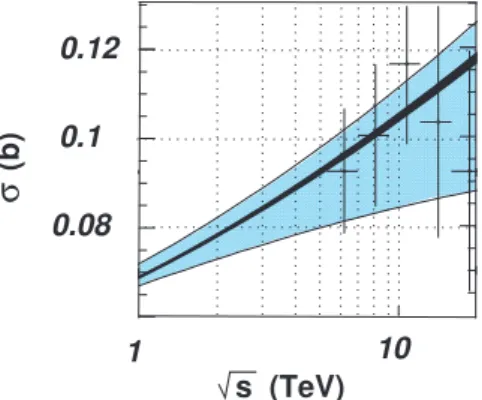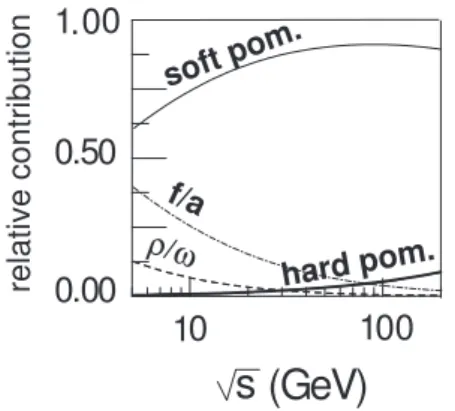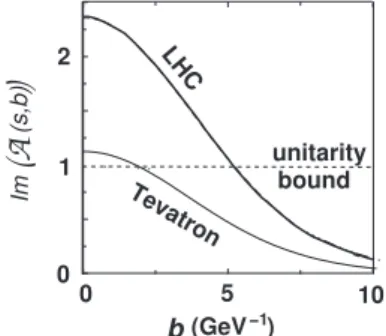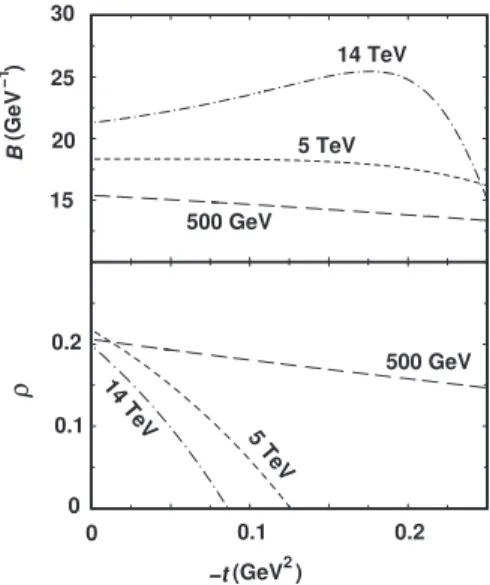Models and Experimental Consequences
J.R. Cudell
IFPA, AGO Dept., Universit´e de Li`ege, Belgium
I review the predictions of the total cross section for many models, and point out that some of them lead to the conclusion that the standard experimental analysis may lead to systematic errors much larger than expected.
The total cross section is a highly non-perturbative object that we cannot predict from QCD. In fact, we have to rely on theoretical ideas that were developed before QCD, in the context of the analytic S matrix, such as analyticity, or the unitarity of partial waves.
The natural place to discuss these ideas is the complex-j plane, where the singularities of the amplitudes determine their behaviour with s. But we do not know these singularities. The simplest ones, which correspond to the exchange of bound states, are simple poles. Accounting for the exchange of meson trajectories is not too hard, as we know their spectrum. But as their contribution falls with s, they will not matter at the LHC. One must thus model the pomeron, for which there is little spectroscopic guidance. Again, the simplest idea is to use a simple pole at j = 1 + ǫ. But we know that if there are simple poles, there must be cuts, which correspond to multiple exchanges. We do not know how to calculate these: we only know general properties of the two-pomeron cut. This means that there are many possibilities, such as eikonal models, U -matrix unitarisation, extended eikonal/U -matrix models, or multi-channel eikonals. These cuts will be needed at the LHC to restore partial-wave unitarity. It is also possible that the pomeron is not an exchange of bound states, so that one should not start from a simple pole, but rather consider multiple poles (double or triple) at j = 1, which automatically obey unitarity.
1
The COMPETE Fits
The multitude of models has been confronted with data, and the COMPETE collaboration [1] gathered and cleaned the datasets which are now available on the servers of the Particle data group [2], and which gather all the soft data measured at√s ≥ 4 GeV and t = 0, i.e. the total cross sections and the ρ parameters when available, for pp, ¯pp, π±p, K±p, γp and γγ. These
data have some drawbacks. First of all, most cross sections have been measured at ISR energies, and there is a gap from √s ≈ 100 GeV to √s ≈ 500 GeV. This gap would have been filled by the pp2pp collaboration at RHIC, but it has unfortunately been stopped. Another problem comes from the highest-energy data, where a 2σ disagreement exists between E710 and CDF. Finally, the compatibility of the various measurements of ρ at ISR energies is questionable, and not enough information has been published to redo the analyses.
Nevertheless, COMPETE considered several hundreds of possible parametrisations, based on simple, double or triple poles, and kept only those which had a global χ2/point smaller
than 1, for √s ≥ 5 GeV. From these, one can predict the total cross section at the LHC, and estimate the error due to the extrapolation. Fig. 1 shows the result of this study. The
0.08 0.12 0.1 1 s (TeV) 10
σ
(b)Figure 1: The COMPETE prediction for the total cross section in the LHC energy region. The inner black band represents our best guess with statistical errors only, the outer band all the parametrisations with χ2/point ≤ 1.
extrapolation of the parametrisations which passed the χ2 test is given by the outer band. It
predicts 84 mb ≤ σ ≤ 112 mb for √s = 10 TeV, and 90–117 mb for 14 TeV.
The inner band of Fig. 1 shows the best guess, and it is based on a series of statistical indica-tors explained in [4]. It corresponds to a universal triple-pole (log2s) parametrisation. One should note that the multiple-pole fits have some peculiar properties: in the triple-pole case, the contribution of the pomeron f alls with s for energies smaller than 6 GeV, whereas in the double-pole case, it actually becomes negative below 9.5 GeV. Simple poles seem to be excluded, but they can be con-sidered again if the lower cut-off on the energy is raised to 10 GeV. The multiple-pole parametrisa-tions have been used successfully [5] to reproduce low-x data in deeply inelastic scattering (DIS), showing that universality does not seem to hold in general, as the coefficient of the triple pole de-pends on Q2. More recently, multiple poles have
been used successfully [6] to reproduce the differential elastic cross sections [7].
Hence multiple-pole fits seem to work, but it is hard to imagine how such a structure may emerge from QCD. On the other hand, simple-pole fits have a simple phenomenology, a simple interpretation as the exchange of glueballs, and only a handful of parameters.
2
The Simple-Pole Fit: Low Energy
Clearly, one simple-pole pomeron has never been a reasonable choice: in their original soft-pomeron model [8], Donnachie and Landshoff included a two-soft-pomeron cut, which lowers the cross section, and which enables one to go to ≈ 40 TeV before unitarity is broken. However, such a simple model seems to produce worse fits than multiple poles. Furthermore, HERA data on DIS and on vector-meson production have lead to the introduction of a second singularity [9], taken also as a simple pole, and mimicking the BFKL cut. One can indeed follow the standard transformation to the j-plane to convince oneself that hadronic singularities must be present in DIS [10]. This new singularity has a coupling which depends on Q2, or on the
vector-meson mass, and, together with the soft pomeron, it enables one to reproduce all HERA measurements [11]. The question then is to know whether such a singularity might be present in soft data.
It actually came as a surprise that, indeed, the introduction of a hard pole brings the simple-pole pomeron fit on equal footing with multiple simple-poles, as far as the χ2/point is concerned [12].
This is true provided that one stops the fit at √s ≈ 200 GeV. Beyond that, the hard pole must be unitarised, as its contribution to the total cross section would be much too large. Nevertheless, it is remarkable that a global fit to soft data leads to a hard pomeron with an
intercept ≈ 1.4, perfectly compatible with that obtained by Donnachie and Landshoff in DIS. It must be noted however that the coupling of the hard pomeron is tiny. It contributes at most 7% to the total cross section for√s < 200 GeV, as shown in Fig. 2. Previous studies [1] considered only fits to the highest energy, in which case the hard pomeron coupling becomes extremely small. Even if the energy is limited to 200 GeV, the coupling remains of the order of 1% of that of the soft pomeron.
10
100
0.00
0.50
1.00
s (GeV)
relative contribution
f/a
ρ/ω
soft pom.
hard pom.
Figure 2: The contribution to the total pp cross section of the two pomerons and the two reggeons, divided by the average of the pp and ¯pp total cross sections.
The two-pomeron model was later applied to the differential elastic cross section in [13], where it was shown that the hard pomeron was compatible with data on the first cone (0.1 GeV2 < |t| ≤ 0.5
GeV2), for energies smaller than 100 GeV,
al-though in this case it did not significantly improve the fit. Note also that the form factors of the var-ious exchanges were directly extracted from the data, confirming the presence of a zero in the form factor of the C = −1 trajectory, and suggesting one for the c = +1 meson trajectory.
One has thus found an alternative to the multiple-pole fits: the two-pomeron model, which can reproduce DIS data, photoproduction data, soft forward data and differential elastic cross sec-tion, provided one stays at moderate energy and small |t|. As we shall now see, if this model is the correct one, then it may have important con-sequences at the LHC.
3
The Simple-Pole Fit: High Energy
Indeed, to go to higher energies, one must confront the question of unitarisation. At high energy, the partial waves can be obtained by a Fourier transform of the amplitude A(s, t) to impact-parameter space, as ℓ ≈ b√s. The unitarity constraint can then be written
|A(s, b)|2≤ 2Im (A(s, b)) .
It is easy to see that this means that the complex A(s, b) has to be in a circle of radius 1 centred at A(s, b) = i/2, which we shall call the unitarity circle (Note that another normalisation is frequently used, where the circle has radius 1 and is centred at i.)
In our two-pomeron model, the amplitude A(s, 0) leaves the unitarity circle for energies slightly below the Tevatron, and it is quite far out at the LHC, as can be seen in Fig. 3. The problem, of course, is that one does not know exactly how the amplitude will stay in the unitarity circle. It is known that multi-pomeron exchanges, and maybe multi-pomeron vertices, will restore unitarity. But how to implement these ingredients is far from unique [14]. Even the simplest two-pomeron cut is not fully calculable, let alone a full resummation.
Mathematically, unitarisation schemes can be classified into three classes. The first one maps the whole upper-half complex plane onto the unitarity circle. In this class, one finds the eikonal scheme, and the U -matrix scheme [16]. Note that the latter is the only one to provide a one-to-one mapping between the half-plane and the circle, but the amplitude also has a new
pole at A(s, b) = −2i. The second class is a simple extension of the first one: instead of mapping the upper half-plane to the full unitarity circle, one maps it to a smaller circle, still centred at A(s, b) = i/2. The third class, which we recently proposed [15], maps a given amplitude to the circle, which is far less restrictive than mapping the half plane. In general, these schemes can have very different properties [15]: they can lead to the Pumplin bound (σel< σtot/2 [17]) and
to shadowing, but it is also possible to have anti-shadowing and σel≈ σtot, both for eikonal-like
and U -matrix-like schemes. I shall not consider these more exotic possibilities here, but one has to bear in mind that they cannot be a priori ruled out.
LHC Tevatron unitarity bound 5 10 0 0 1 2 Im
(A )
(s,b) (GeV ) b −1Figure 3: The imaginary part of the am-plitude A(s, b) at the Tevatron and at the LHC, before unitarisation. (TeV) s bare saturated eikonal 10 1 0.1 60 90 150 120 180 σtot (mb)
Figure 4: Total cross section in a two-pomeron model without (bare) and with simple unitarisation schemes.
As we do not know what scheme to use, we have decided to be conservative, and to unitarise the two-pomeron model using the simplest and most conservative approach. The minimal scheme assumes that something happens when the amplitude reaches the unitarity bound, and one simply cuts-off the amplitude at 1. We shall call it the saturation scheme. Note that to do that while preserving analytic properties is not very simple, but nevertheless it can be done [18]. The other scheme is the standard one-channel eikonal.
Using either of these schemes produces an amplitude which respects unitarity, and thus can be used to predict the total cross section at the LHC. The first scheme keeps by definition the results of the fit below the Tevatron energy, and thus one can keep the parameters of the low-energy simple-pole fit. The eikonal on the other hand changes slightly the low-low-energy results, and thus necessitates some re- fitting. The result is shown in Fig. 4. One sees that, in this very simple approach, the total cross section could be as large as 150 mb. It is interesting to note that a similar number has been obtained by Landshoff, in a very different manner [14].
4
The Measurement of σ
totThe unitarised two-pomeron model has a consequence that has been overlooked so far. As the energy grows, the protons become blacker, and edgier. This in turn changes the diffraction pattern, i.e. the exponential slope of the cross section varies quickly with t: the differential cross section cannot be approximated any longer by eBt
with B constant. In turn, the real part of the amplitude also develops a strong t dependence, and ρ(0) could be as large as 0.24. We
have checked that this is the case for the eikonal scheme, and for the saturation scheme [18], and show the results for the latter in Fig. 5.
(GeV )2 −t (GeV ) −1 B 500 GeV 500 GeV 5 TeV 5 TeV 14 TeV 14 TeV 0 0.1 0.2 0 0.1 0.2 30 25 20 15 ρ
Figure 5: The slope B and the ration of the real to the imaginary parts of the ampli-tude for pp scattering, for various energies, in the saturation scheme.
A hadronic slope B almost constant with t for |t| < 0.25 GeV2 and a small ρ parameter
are standard assumptions for the planned mea-surement of the total cross section [19]. If the two-pomeron model is correct, then these as-sumptions will be wrong, and we can evaluate the systematic uncertainty that they will gen-erate. So, we have used our unitarised two-pomeron model [20] to simulate data, using bins and errors similar to those of the UA4/2 exper-iment [21], and including the Coulomb-nucleon interference [22]. We then performed the stan-dard analysis on these simulated data, and ex-tracted a measurement of the total cross sec-tion, which we could compare to the input value from our model. The result of this analysis is that the extracted value of the total cross section will systematically overshoot the model value by about 10 mb in a luminosity-dependent method, and about 15 mb in a luminosity-independent one. Hence, an additional study of the t depen-dence of the slope and of the ρ parameter will be needed before one reaches the 1 % precision level.
5
Conclusion
The measurement of the total cross section at the LHC will tell us a lot about the analytic structure of the amplitude, as there is a variety of predictions that span the region from 90 to 230 mb:
• σtot> 200 mb: the only unitarisation scheme able to accommodate such a large number is
the U matrix [16]. It basically predicts the same inelastic cross section as more standard schemes, but the elastic cross section is much larger, and accounts for the difference. • 120 mb < σtot < 160 mb: this would be a clear signal for a two-pomeron model, and
would also tell us about the unitarisation scheme.
• σtot ≈ 110 mb: this is the standard prediction not only of the COMPETE fits, but also
of many models based on a simple eikonal and only one pomeron pole.
• σtot< 100 mb: this would indicate either the validity of double-pole parametrisations, or
And finally, if one really enters a new regime at the LHC, the study of the t dependence of the elastic cross section, and of the real part of the amplitude, may be of great importance to unravel the underlying dynamics and to improve the experimental measurement of σtot.
Acknowledgements
I acknowledge the contribution of my collaborators of the COMPETE collaboration to the investigations summarised here, and in particular of A. Lengyel, E. Martynov and O.V. Selyugin. I also acknowledge discussions with A. Donnachie, P.V. Landshoff, U. Maor and S. Troshin, and thank Karine Gilson for a careful proofreading.
References
[1] J. R. Cudell, V. Ezhela, K. Kang, S. Lugovsky and N. Tkachenko, Phys. Rev. D 61 (2000) 034019 [Erratum-ibid. D 63 (2001) 059901] [arXiv:hep-ph/9908218]; J. R. Cudell et al., Phys. Rev. D 65 (2002) 074024 [arXiv:hep-ph/0107219].
[2] See http://pdg.lbl.gov/2009/hadronic-xsections/hadron.html
[3] J. R. Cudell et al. [COMPETE Collaboration], Phys. Rev. Lett. 89 (2002) 201801 [arXiv:hep-ph/0206172]. [4] J. R. Cudell et al. [COMPETE collaboration], arXiv:hep-ph/0111025.
[5] J. R. Cudell and G. Soyez, Phys. Lett. B 516 (2001) 77 [arXiv:hep-ph/0106307].
[6] E. Martynov and B. Nicolescu, Eur. Phys. J. C 56 (2008) 57 [arXiv:0712.1685 [hep-ph]]; E. Martynov, Phys. Rev. D 76 (2007) 074030 [arXiv:hep-ph/0703248].
[7] A complete dataset for differential elastic cross sections is available at http://www.theo.phys.ulg.ac.be/∼cudell/data/
[8] A. Donnachie and P. V. Landshoff, Nucl. Phys. B 231 (1984) 189; Nucl. Phys. B 267 (1986) 690. [9] A. Donnachie and P. V. Landshoff, Phys. Lett. B 437 (1998) 408 [arXiv:hep-ph/9806344].
[10] J. R. Cudell, A. Donnachie and P. V. Landshoff, Phys. Lett. B 448 (1999) 281 [Erratum-ibid. B 526 (2002) 413] [arXiv:hep-ph/9901222].
[11] A. Donnachie and P. V. Landshoff, arXiv:0803.0686 [hep-ph]; Phys. Lett. B 550 (2002) 160 [arXiv:hep-ph/0204165]; A. Donnachie and P. V. Landshoff, Phys. Lett. B 518 (2001) 63 [arXiv:hep-ph/0105088]. [12] J. R. Cudell, E. Martynov, O. V. Selyugin and A. Lengyel, Phys. Lett. B 587 (2004) 78
[arXiv:hep-ph/0310198].
[13] J. R. Cudell, A. Lengyel and E. Martynov, Phys. Rev. D 73 (2006) 034008 [arXiv:hep-ph/0511073]. [14] P. V. Landshoff, arXiv:0903.1523 [hep-ph].
[15] J. R. Cudell, E. Predazzi and O. V. Selyugin, Phys. Rev. D 79 (2009) 034033 [arXiv:0812.0735 [hep-ph]]. [16] Sergey Troshin, these proceedings; S. M. Troshin and N. E. Tyurin, Eur. Phys. J. C 21 (2001) 679
[arXiv:hep-ph/0004084]; C. T. Sachrajda and R. Blankenbecler, Phys. Rev. D 12 (1975) 1754. [17] J. Pumplin, Phys. Rev. D 8 (1973) 2899.
[18] J. R. Cudell and O. V. Selyugin, Phys. Lett. B 662 (2008) 417 [arXiv:hep-ph/0612046].
[19] Jan Kaspar, these proceedings; G. Anelli et al. [TOTEM Collaboration], JINST 3 (2008) S08007. [20] J. R. Cudell and O. V. Selyugin, Phys. Rev. Lett. 102 (2009) 032003 [arXiv:0812.1892 [hep-ph]]. [21] C. Augier et al. [UA4/2 Collaboration], Phys. Lett. B 316 (1993) 448.
[22] O. V. Selyugin, Mod. Phys. Lett. A 11 (1996) 2317.
[23] Uri Maor, these proceedings; E. Gotsman, E. Levin, U. Maor and J. S. Miller, Eur. Phys. J. C 57 (2008) 689 [arXiv:0805.2799 [hep-ph]];



